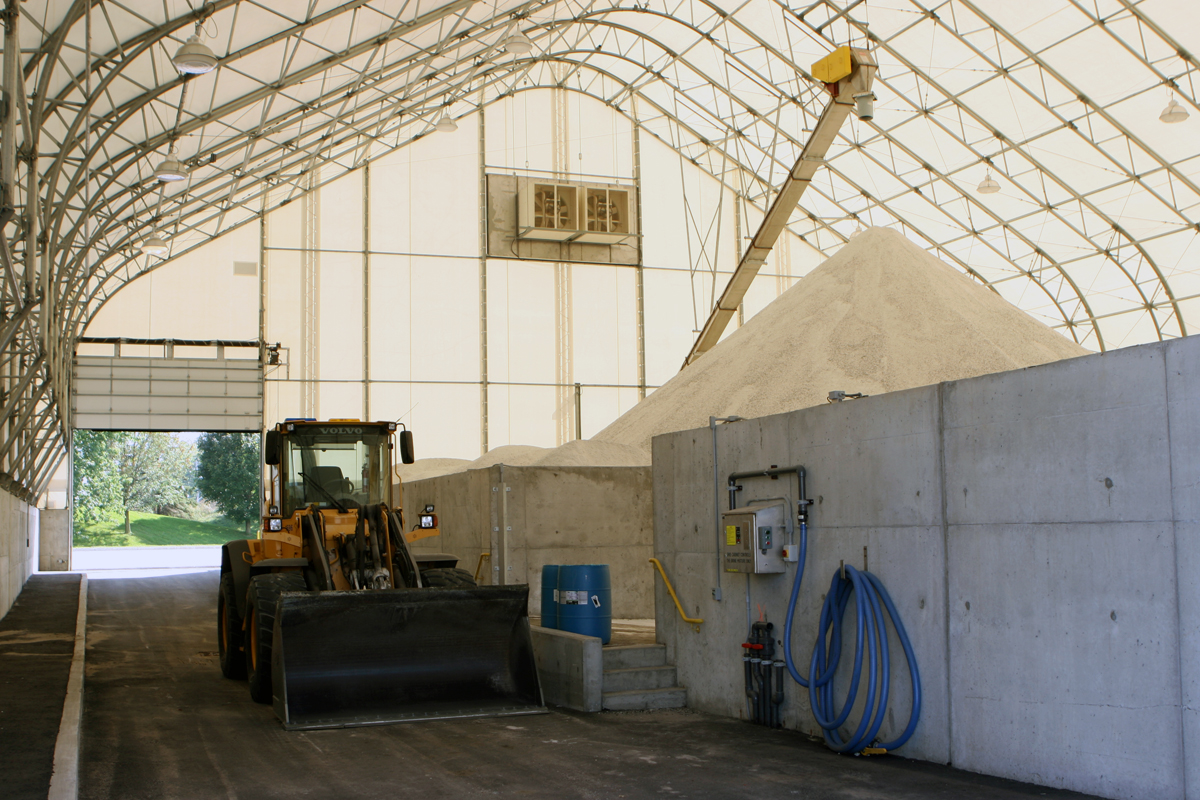When asked where salt is spread, many people will probably say roads. It’s true; levels of service requirements in Ontario make salt the prime tool in keeping roads safe. However, a lot of salt is also spread on parking lots, sidewalks and community trails. Unfortunately, because salt isn’t regulated and can be bought and used by anyone, the data for how much salt is spread on surfaces other than roads is not easy to get or reliable. Compared to roads, the application rate (how much salt spread in a measured area) for parking lots and walkways is thought to be two to three times greater. This is where we have the most opportunity to reduce chloride application.

There are many reasons for potential over salting of parking lots and walkways that include lack of maintenance standards, outdated technology, and liability concerns. Municipal snowplow operators who clear the roads must participate in winter maintenance training that includes salt management principals and have access to resources and current technologies related to winter operations to maintain winter roads in the most efficient way possible.
Here are just some of the ways municipalities are better managing salt use while keeping roads safer for your community:
- Snowplow operators receive training on how weather events can affect road surfaces and best management practices for salt
- Road and atmospheric weather sensors provide operations staff monitoring road conditions with data to determine the appropriate course of action

- Depending on weather and road conditions, some of the materials used may include:
- Direct Liquid Application. This involves spraying a salt liquid on the road prior to a winter storm – referred to as anti-icing – to prevent ice and frost from forming and bonding to the pavement. Anti-icing uses less salt and increases the effectiveness of plowing early in the storm.
- Pre-wetted salt. This is dry road salt with liquid salt brine applied on the dry salt before it is spread on the road. This helps the salt stick to the road surface and speeds up the effectiveness of the salt to form a salt brine solution on the pavement.
- Sand. Can be used on its own or in combination with salt to provide traction when salt is less effective when temperatures fall below -12 degrees Celsius.
Salt brine is a mixture of water and a salt such as sodium chloride, magnesium chloride or calcium chloride. The type of salt used determines the working temperature of the brine.
- Snowplows are equipped with:
- Electronic spreader controls. Predetermined application rates ensure the correct amount of material is applied by the operator who selects rate of salt or sand based on the road and weather conditions.
- Infrared thermometers. Provides continuous, accurate road and air temperature readings to assist the operator in the effective use of salt.
- Global Positioning System. Records the location of the snow plows and amount of salt applied. Operations staff can review the information to minimize the application of salt while achieving the required level of service.
- Blade technology. Snow plow blades follow the contours of the road to allow for the maximum amount of snow and ice to be removed mechanically thus reducing the amount of salt required.
- Enclosed storage areas keep salt contained from outside exposure protecting the natural environment.

- Snow fences in strategic locations and establishing new hedgerows help reduce snow drifting on to roads, which generally leads to the need for less salt.


Parts of a snowplow:
- Snow plow blade (front) – Mechanically removes snow and ice from the road reducing the amount of salt that is required to treat the road.
- Snow plow blade (wing plow) – moves snow to the side of the road.
- Conveyor – moves the salt from the hopper to the chute.
- Tank – holds the pre wetting liquid to be sprayed on the salt.
- Hopper – holds large amounts of salt the snow plow uses.
- Liquid nozzle – sprays pre-wetting liquid on the salt as the salt travels along the conveyor. The liquid helps the salt work faster to form a brine requiring less salt to be applied on the road.
- Chute – directs the salt from the conveyor to the spinner.
- Spinner – controls the width of material that is being placed on the road.
- Temperature display – shows the air and pavement temperatures so the snow plow driver knows when salt will work best.
- Material application controller – allows the snow plow driver to control the amount of salt spread on the road.
- Plow controller – allows the snow plow driver to move the front and wing plows.
How can you help?
- Switch to winter tires
- Drive for the weather conditions and give yourself extra time to arrive at your destination
- Respect winter plowing operations. Operators are out to make the roads safe. Avoid passing a snow plow and show courtesy to the job they are doing.
- When possible, consider leaving your car at home and taking public transit
Safe travels, Groundwater
Have you ever wondered what’s involved with clearing snow and ice from roads? Snowplows are not just a truck with a plow. Read this I Am Groundwater blog to learn about the technology and equipment onboard. #iamgroundwaterblog
Tweet
Related posts:

Great info, thank you for posting it.
LikeLike
Thanks Geri for the feedback – much appreciated!
LikeLiked by 1 person